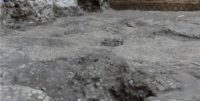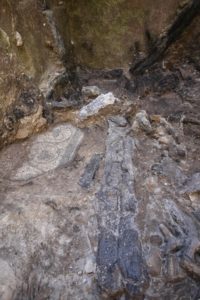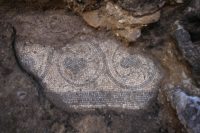 The construction of Rome’s Metro Line C continues to be the archaeological gift that keeps on giving. The latest discovery is an early 3rd century villa that collapsed in a fire. The intense heat of the blaze charred wooden beams and the collapse of the structure on top of them helped preserved the organic remains for 1,800 years.
The construction of Rome’s Metro Line C continues to be the archaeological gift that keeps on giving. The latest discovery is an early 3rd century villa that collapsed in a fire. The intense heat of the blaze charred wooden beams and the collapse of the structure on top of them helped preserved the organic remains for 1,800 years.
Organic remains preserved by instant carbonization have been found at Pompeii and Herculaneum, but those cities succumbed to a cataclysmic volcanic eruption that froze everything in time. Buildings burned down in Rome all the time, some fires spreading rapidly throughout the city like the Great Fire of 64 A.D. over which Nero is said to have sung mournfully about the destruction of Troy, some relatively contained either by (rudimentary) firefighting measures or by a fortuitous separation between buildings.
 Surviving organic remains, however, are extremely rare in the city of Rome. Even though the tightly-packed, wood-heavy ancient city was subject to regular conflagrations, most of the evidence for them in the archaeological record consists of marks, dark spots indicating charring. Thousands of years of battling the water table and Tiber floods and construction over construction have made Rome a tough environment for the preservation of wood, textiles and organics of any type. The discovery of fire-preserved wood from a villa in the city is therefore an extremely exciting find.
Surviving organic remains, however, are extremely rare in the city of Rome. Even though the tightly-packed, wood-heavy ancient city was subject to regular conflagrations, most of the evidence for them in the archaeological record consists of marks, dark spots indicating charring. Thousands of years of battling the water table and Tiber floods and construction over construction have made Rome a tough environment for the preservation of wood, textiles and organics of any type. The discovery of fire-preserved wood from a villa in the city is therefore an extremely exciting find.
“The fire that stopped life in this environment allows us to image life in a precise moment,” said Francesco Prosperetti, in charge of Rome’s archaeological ruins and excavations.
Experts say the Rome ruins might be from an aristocrat’s home at the foot of the nearby Celian Hill or from a nearby military barracks, which itself had been explored in other excavations for the subway line.
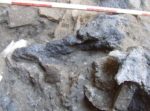 The remains were discovered last month at the bottom of a 33-foot hole bored into Rome’s undercarriage near the ancient Aurelian Walls (built between 271 and 275 A.D.). The most significant find was a charred wooden ceiling that collapsed during the fire. It is unique in Rome’s archaeological record. Pieces of furniture, hardened by the fire, also survived: the leg of a stool or table, a larger leg or foot believed to have come from a trunk, and two tables, one large rectangular one, one smaller piece. Other surviving wooden architectural features include a wooden railing or balustrade, rectangular wooden joists that acted as anchors for the rods that attach the
The remains were discovered last month at the bottom of a 33-foot hole bored into Rome’s undercarriage near the ancient Aurelian Walls (built between 271 and 275 A.D.). The most significant find was a charred wooden ceiling that collapsed during the fire. It is unique in Rome’s archaeological record. Pieces of furniture, hardened by the fire, also survived: the leg of a stool or table, a larger leg or foot believed to have come from a trunk, and two tables, one large rectangular one, one smaller piece. Other surviving wooden architectural features include a wooden railing or balustrade, rectangular wooden joists that acted as anchors for the rods that attach the 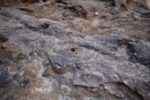 plaster to the ceilings and walls, and a large support beam for the floor that Vitruvius described in De architectura as a contignatio. The beam still has notches where the transverse beams were once installed and a large iron nail driven into the middle of it. Fragments of a wooden window jamb with traces of the glass panes still extant were also found.
plaster to the ceilings and walls, and a large support beam for the floor that Vitruvius described in De architectura as a contignatio. The beam still has notches where the transverse beams were once installed and a large iron nail driven into the middle of it. Fragments of a wooden window jamb with traces of the glass panes still extant were also found.
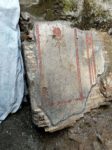 Non-organic features have survived in fine condition as well. There are frescoed sections of brickwork wall dating to the reign of Emperor Septimius Severus (late 2nd, early 3rd century) decorated with delicate red florals against a white background. Part of a black-and-white mosaic floor that had once been on the upper story of the building survived its plummet with its handsome double border, heart-shaped leaves and wave pattern intact.
Non-organic features have survived in fine condition as well. There are frescoed sections of brickwork wall dating to the reign of Emperor Septimius Severus (late 2nd, early 3rd century) decorated with delicate red florals against a white background. Part of a black-and-white mosaic floor that had once been on the upper story of the building survived its plummet with its handsome double border, heart-shaped leaves and wave pattern intact.
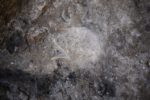 In another nod to famous Pompeiian finds, the skeleton of a dog still posed in the crouching stance it was in when it died, was found at the door of the house. Archaeologists think it was trying to escape the fire but was trapped by falling debris when the building collapsed. The dog’s jaw complete with
In another nod to famous Pompeiian finds, the skeleton of a dog still posed in the crouching stance it was in when it died, was found at the door of the house. Archaeologists think it was trying to escape the fire but was trapped by falling debris when the building collapsed. The dog’s jaw complete with 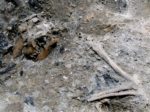 teeth has remained surprisingly intact. The skeleton of a second smaller animal found at the site, possibly the dog’s puppy or a cat, has yet to be identified.
teeth has remained surprisingly intact. The skeleton of a second smaller animal found at the site, possibly the dog’s puppy or a cat, has yet to be identified.
The architectural and decorative materials are all in good state of preservation thanks to the fire, and archaeologists will study them in detail to discover new information about how wealthy Romans of the 3rd century lived, how their homes were built and furnished. Italy’s National Institute of Geophysics and Volcanology (INGV) will also study the site. They hope to determine whether the fire and collapse were caused by an earthquake.
